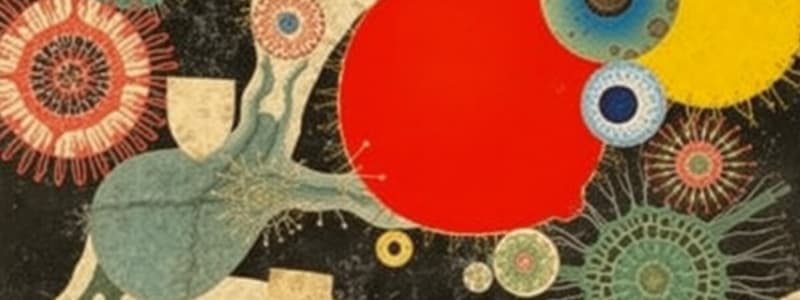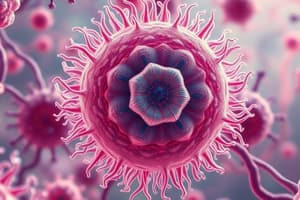Podcast
Questions and Answers
Which of the following best describes the study of interactions between organisms and their surroundings?
Which of the following best describes the study of interactions between organisms and their surroundings?
- Microbiology
- Taxonomy
- Physiology
- Ecology (correct)
What is a key mechanism that drives evolution, resulting in advantageous traits becoming more common in a population?
What is a key mechanism that drives evolution, resulting in advantageous traits becoming more common in a population?
- Genetic Drift
- Natural Selection (correct)
- Metabolic Processing
- Adaptation
Which process best describes how an organism becomes better suited to its environment through evolutionary changes?
Which process best describes how an organism becomes better suited to its environment through evolutionary changes?
- Phylogeny
- Taxonomy
- Speciation
- Adaptation (correct)
Which of the following BEST defines the purpose of taxonomy in biology?
Which of the following BEST defines the purpose of taxonomy in biology?
Which statement best describes the role of microorganisms in ecosystems?
Which statement best describes the role of microorganisms in ecosystems?
Which cellular structure is responsible for modifying and packaging proteins and lipids?
Which cellular structure is responsible for modifying and packaging proteins and lipids?
What is the primary function of the cell membrane?
What is the primary function of the cell membrane?
Which process is responsible for creating two genetically identical daughter cells?
Which process is responsible for creating two genetically identical daughter cells?
What is the primary role of ribosomes in cellular function?
What is the primary role of ribosomes in cellular function?
Which of the following is a characteristic of active transport?
Which of the following is a characteristic of active transport?
What is the main function of chloroplasts in plant cells?
What is the main function of chloroplasts in plant cells?
Where is the genetic material (DNA) primarily located in a eukaryotic cell?
Where is the genetic material (DNA) primarily located in a eukaryotic cell?
What best describes the role of enzymes in biochemical reactions?
What best describes the role of enzymes in biochemical reactions?
Flashcards
Metabolic processes
Metabolic processes
Chemical processes that occur within an organism to maintain life.
Natural selection
Natural selection
Mechanism of evolution where favorable traits survive and reproduce more effectively.
Taxonomy
Taxonomy
Science of classifying organisms into hierarchical groups based on traits.
Phylogeny
Phylogeny
Signup and view all the flashcards
Microorganisms
Microorganisms
Signup and view all the flashcards
Prokaryotic Cells
Prokaryotic Cells
Signup and view all the flashcards
Eukaryotic Cells
Eukaryotic Cells
Signup and view all the flashcards
Cell Membrane
Cell Membrane
Signup and view all the flashcards
Mitochondria
Mitochondria
Signup and view all the flashcards
Photosynthesis
Photosynthesis
Signup and view all the flashcards
Mitosis
Mitosis
Signup and view all the flashcards
Genes
Genes
Signup and view all the flashcards
Active Transport
Active Transport
Signup and view all the flashcards
Study Notes
Cell Structure and Function
- Cells are the basic units of life, exhibiting varied structures and functions.
- Prokaryotic cells (bacteria and archaea) lack a nucleus and membrane-bound organelles.
- Eukaryotic cells (animals, plants, fungi, protists) contain a nucleus and membrane-bound organelles.
- The cell membrane is a selectively permeable barrier, regulating the passage of substances.
- Cytoplasm is the jelly-like substance inside the cell, supporting organelles.
- The nucleus contains genetic material (DNA) and controls cell activities.
- Mitochondria are the "powerhouses" of the cell, producing ATP.
- Ribosomes synthesize proteins.
- Endoplasmic reticulum (ER) assists in protein and lipid synthesis.
- Golgi apparatus modifies, sorts, and packages proteins and lipids.
- Lysosomes contain digestive enzymes for waste breakdown.
- Vacuoles store water, nutrients, and waste products.
- Chloroplasts (in plant cells) carry out photosynthesis.
- Cytoskeleton provides support and allows cell movement.
Cellular Processes
- Cellular respiration is the process where cells break down glucose to release energy.
- Photosynthesis is the process where plants use sunlight to convert carbon dioxide and water into glucose.
- Mitosis is a type of cell division that results in two genetically identical daughter cells.
- Meiosis is a specialized type of cell division that produces gametes.
- DNA replication is the process of creating an identical copy of a DNA molecule.
- Protein synthesis involves transcription (DNA to RNA) and translation (RNA to protein).
- Enzymes are biological catalysts that speed up chemical reactions.
- Active transport requires energy to move molecules across the cell membrane against their concentration gradient.
- Passive transport does not require energy and occurs along the concentration gradient.
- Homeostasis is the ability of an organism to maintain internal stability.
Genetics
- Genes are segments of DNA that code for proteins.
- DNA is the hereditary material that carries genetic information.
- RNA plays a crucial role in protein synthesis.
- Mutations are changes in DNA sequence, which can be harmful, beneficial, or neutral.
- Mendelian genetics describes patterns of inheritance.
- Non-Mendelian genetics describes patterns of inheritance that deviate from Mendelian principles.
- Genetic engineering involves modifying an organism's genes.
- Cell signaling is the communication process between cells, enabling coordinated responses.
Organismal Biology
- Organisms interact with their environment through various metabolic processes.
- Organisms exhibit different levels of organization, from cells to populations and communities.
- Ecology studies the relationships between organisms and their environment.
- Evolution is the change in heritable characteristics of biological populations over successive generations.
- Natural selection is a key mechanism of evolution, where advantageous traits become more common in a population.
- Adaptation is an evolutionary process where an organism becomes better suited for its environment.
Biological Diversity
- Taxonomy classifies organisms into hierarchical groups based on shared characteristics.
- Phylogeny describes the evolutionary relationships among organisms.
- Species are groups of organisms that can interbreed and produce fertile offspring.
- There are diverse kingdoms of life representing various lineages.
Microbiology
- Microorganisms include bacteria, archaea, fungi, protists and viruses.
- Microorganisms play vital roles in ecosystems, decomposing organic matter and nutrient cycling.
- Pathogenic microorganisms cause disease in other organisms.
- Microbiology involves the study of microorganisms and their effects.
- Techniques for studying microorganisms include microscopy and culturing.
Studying That Suits You
Use AI to generate personalized quizzes and flashcards to suit your learning preferences.




